Submitted:
26 July 2024
Posted:
29 July 2024
You are already at the latest version
Abstract
Keywords:
1. Introduction
2. Geological Setting
2.1. The 1st Study Area Kleisoura Valley, Ano Doliana
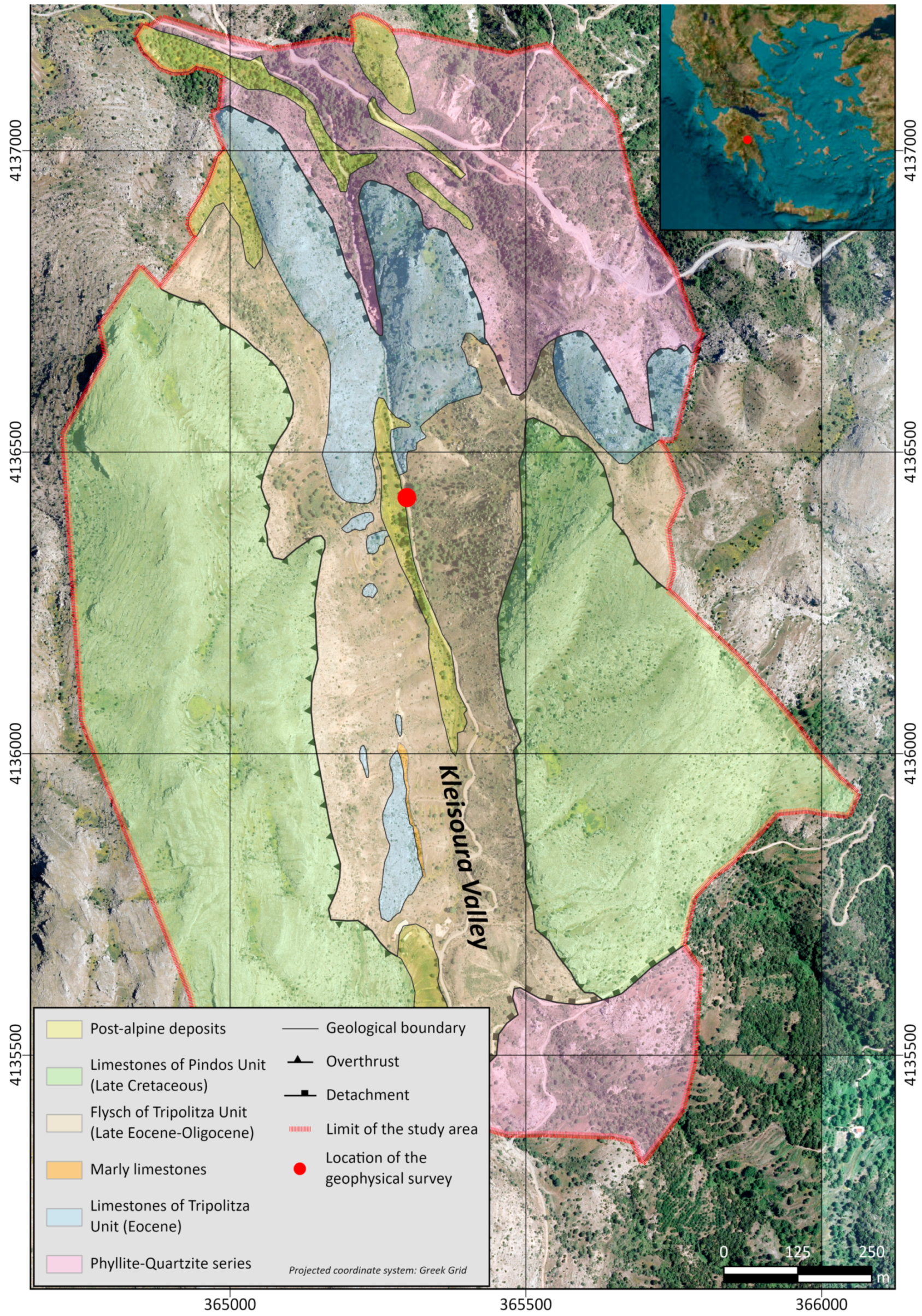
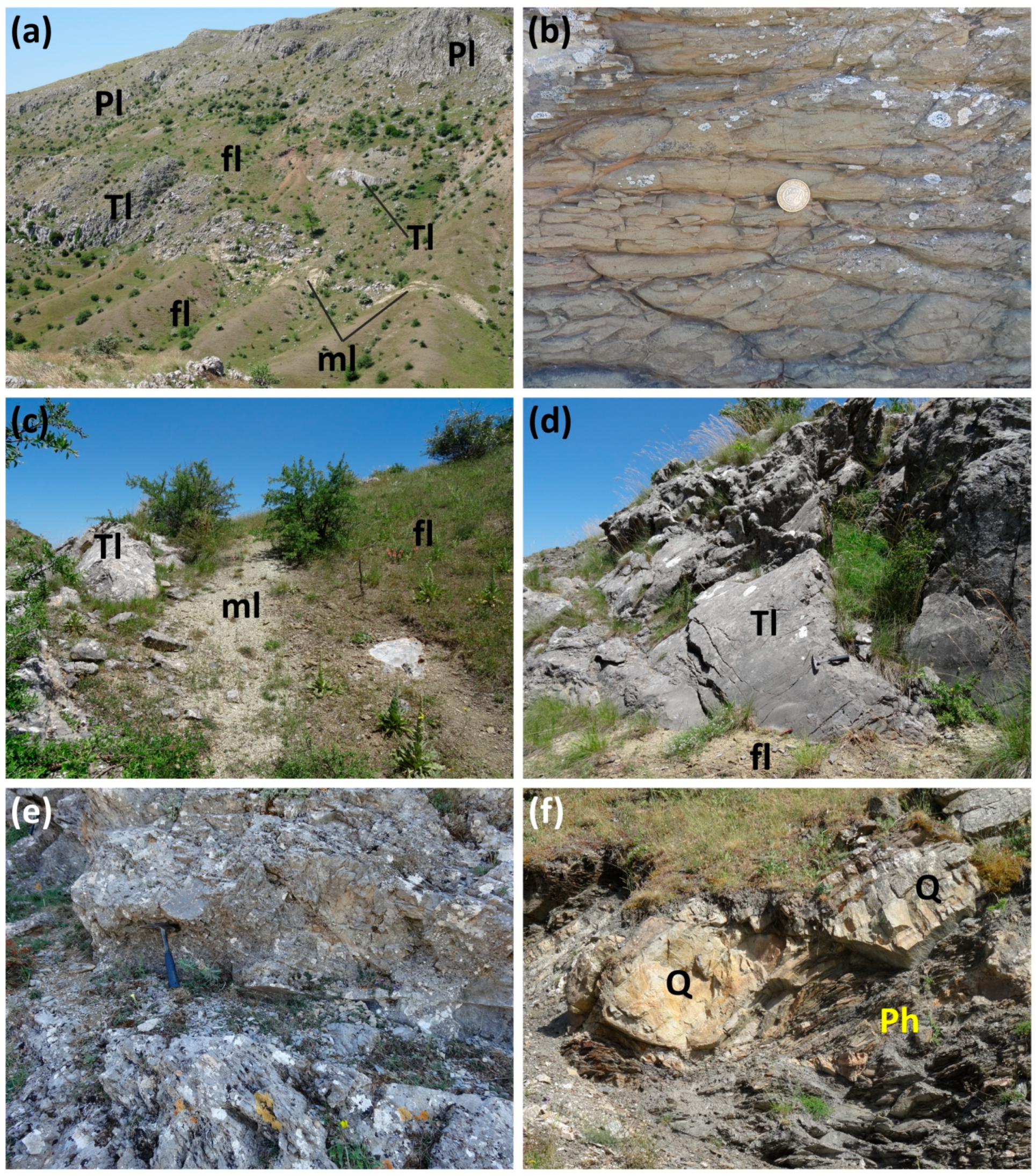
2.2. The 2nd Study Area “Plaka”
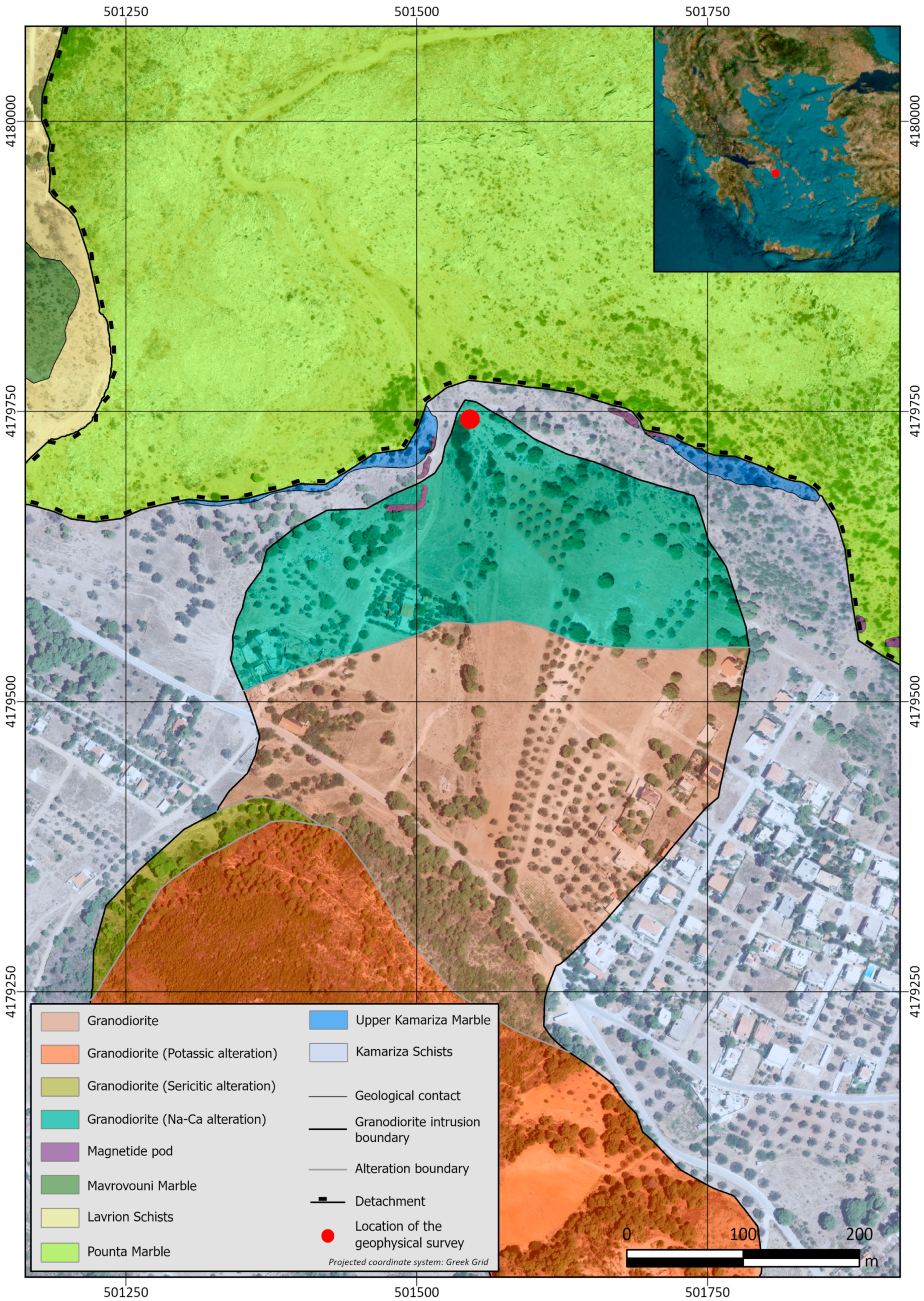
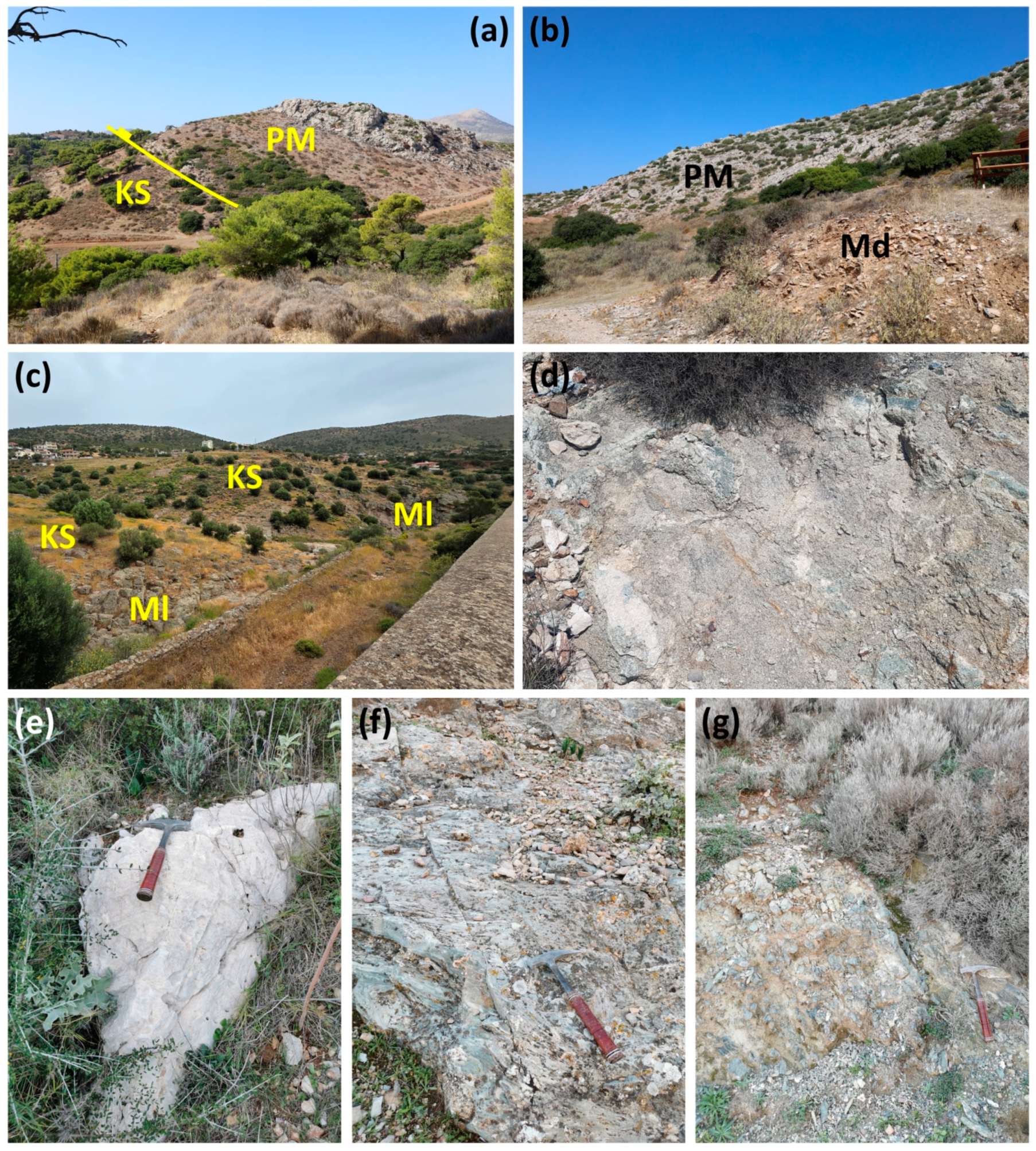
3. Methodology
3.1. Electrical Resistivity Tomography
3.1.1. Data Acquisition
3.1.2. Processing
3.2. Seismic Refraction Tomography
3.2.1. Data Acquisition
3.2.2. Processing
- Creation of synthetic seismic data (2D forward modeling), to determine the extent to which the SRT technique can provide a velocity model that best represents the complex subsurface structure characterizing the two study areas. Furthermore, by comparing the synthetic seismic records with the field seismic records, it was possible to attribute certain characteristics observed in the records to specific subsurface structures.
- Analysis and comparison of the seismic records acquired from the five different seismic sources to determine the type of seismic source that performed best in the specific geo-environment, providing the seismic records characterized by the highest S/N ratio.
- First brakes picking and inversion of the seismic data, to calculate the subsurface velocity models in the two study areas.
3.3. Ground Penetrating Radar
3.3.1. Data Acquisition
3.3.2. Processing
4. Results and Discussion
4.1. Forward Modeling
4.2. Source Comparsion
4.3. Field Data Results of the 1st Study Area Kleisoura Valley, Ano Doliana
4.4. Field Data Results of the 2nd Study Area “Plaka”
5. Conclusions
Author Contributions
Funding
Data Availability Statement
Acknowledgments
Conflicts of Interest
References
- Quigley, P. T. Ground proving seismic refraction tomography (SRT) in laterally variable karstic limestone terrain. Doctoral dissertation, University of Florida, 2006.
- Akingboye, A.S.; Ogunyele, A.C. Insight into seismic refraction and electrical resistivity tomography techniques in subsurface investigations. Rudarsko-geološko-naftni zbornik 2019, 34, 93–111. [Google Scholar] [CrossRef]
- Mazzotti, A.; Stucchi, E.; Fradelizio, G.; Zanzi, L.; Scandone, P. Seismic exploration in complex terrains: A processing experience in the Southern Apennines. Geophysics 2000, 65, 1402–1417. [Google Scholar] [CrossRef]
- Improta, L.; Zollo, A.; Herrero, A.; Frattini, R.; Virieux, J.; Dell’Aversana, P. Seismic imaging of complex structures by non-linear traveltime inversion of dense wide-angle data: Application to a thrust belt. Geophysical Journal International 2002, 151, 264–278. [Google Scholar] [CrossRef]
- Loke, M. H. Tutorial: 2-D and 3-D electrical imaging surveys, 2004; 128p.
- Improta, L.; Ferranti, L.; De Martini, P. M.; Piscitelli, S.; Bruno, P. P.; Burrato, P.; Civico, R.; Giocoli, A.; Iorio, M.; D'Addezio, G.; Maschio, L. Detecting young, slow-slipping active faults by geologic and multidisciplinary high-resolution geophysical investigations: A case study from the Apennine seismic belt, Italy. Journal of Geophysical Research 2010, 115. [Google Scholar] [CrossRef]
- Giocoli, A.; Stabile, T.A.; Adurno, I.; Perrone, A.; Gallipoli, M.R.; Gueguen, E.; Norelli, E.; Piscitelli, S. Geological and geophysical characterization of the Southeastern side of the high agri valley (Southern Apennines, Italy). Natural Hazards and Earth System Sciences 2015, 15, 315–323. [Google Scholar] [CrossRef]
- Giano, S. I.; Lapenna, V.; Piscitelli, S.; Schiattarella, M. Electrical imaging and self-potential surveys to study the geological setting of the Quaternary, slope deposits in the Agri high valley (Southern Italy). ANNALS OF GEOPHYSICS 2000, 43, 409–419. [Google Scholar] [CrossRef]
- Nguyen, F.; Garambois, S.; Jongmans, D.; Pirard, E.; Loke, M.H. Image processing of 2D resistivity data for imaging faults. Journal of Applied Geophysics 2005, 57, 260–277. [Google Scholar] [CrossRef]
- Diaferia, I.; Barchi, M.; Loddo, M.; Schiavone, D.; Siniscalchi, A. Detailed imaging of tectonic structures by multiscale Earth resistivity tomographies: The Colfiorito normal faults (Central Italy). Geophysical Research Letters 2006, 33. [Google Scholar] [CrossRef]
- Giocoli, A.; Burrato, P.; Galli, P.; Lapenna, V.; Piscitelli, S.; Rizzo, E.; Romano, G.; Siniscalchi, A.; Magrí, C.; Vannoli, P. Using the ERT method in tectonically active areas: Hints from Southern Apennine (Italy). Advances in geosciences 2008, 19, 61–65. [Google Scholar] [CrossRef]
- Kumar, D.; Subba Rao, D.V.; Mondal, S.; Sridhar, K.; Rajesh, K.; Satyanarayanan, M. Gold - sulphide mineralization in ultramafic-mafic-granite complex of Jashpur, Bastar craton, central India: Evidences from geophysical studies. Journal of the Geological Society of India 2017, 90, 147–153. [Google Scholar] [CrossRef]
- Alexopoulos, J. D.; Dilalos, S.; Vassilakis, E. Adumbration of Amvrakia’s spring water pathways, based on detailed geophysical data (Kastraki-Meteora). In Advances in the Research of Aquatic Environment; Springer Berlin Heidelberg: Berlin, Germany, 2011; Volume 2, pp. 105–112. [Google Scholar]
- Muchingami, I.; Hlatywayo, D.J.; Nel, J.M.; Chuma, C. Electrical resistivity survey for groundwater investigations and shallow subsurface evaluation of the basaltic-greenstone formation of the urban Bulawayo aquifer. Physics and Chemistry of the Earth, 2012, 50-52, 44–51. [Google Scholar] [CrossRef]
- Gkosios, V.; Alexopoulos, J. D.; Giannopoulos, I. K.; Mitsika, G. S.; Dilalos, S.; Barbaresos, I.; Voulgaris, N. Determination of the subsurface geological regime and geotechnical characteristics at the area of Goudi (Athens, Greece) derived from geophysical measurements. In Bulletin of the Geological Society of Greece, Special Publication GSG2022-062. In Proceedings of the 16th International Congress of the Geological Society of Greece, Patras, Greece, 17-19 October 2022. [Google Scholar]
- Alexopoulos, J.D.; Gkosios, V.; Dilalos, S.; Giannopoulos, I. K.; Mitsika, G. S.; Barbaresos, I.; Voulgaris, N. Assessment of near-surface geophysical measurements for geotechnical purposes at the area of Goudi (Athens, Greece). In NSG2023 29th European Meeting of Environmental and Engineering Geophysics, 1, 1-5, Edinburgh, UK, 3-7 September 2023. [CrossRef]
- Alexopoulos, J.D.; Dilalos, S.; Voulgaris, N.; Gkosios, V.; Giannopoulos, I. K.; Kapetanidis, V.; Kaviris, G. The contribution of near-surface geophysics for the site characterization of seismological stations. Applied sciences 2023, 13, 4932–4932. [Google Scholar] [CrossRef]
- Zhang, J.; ten Brink, U.S.; Toksöz, M.N. Nonlinear refraction and reflection travel time tomography. Journal of Geophysical Research: Solid Earth 1998, 103, 29743–29757. [Google Scholar] [CrossRef]
- Cardarelli, E.; de Nardis, R. Seismic refraction, isotropic anisotropic seismic tomography on an ancient monument (Antonino and Faustina temple Ad 141). Geophysical Prospecting 2001, 49, 228–240. [Google Scholar] [CrossRef]
- Villani, F.; Tulliani, V.; Sapia, V.; Fierro, E.; Civico, R.; Pantosti, D. Shallow subsurface imaging of the Piano Di Pezza active normal fault (Central Italy) by high-resolution refraction and electrical resistivity tomography coupled with time-domain electromagnetic data. Geophysical Journal International 2015, 203, 1482–1494. [Google Scholar] [CrossRef]
- Improta, L.; Zollo, A.; Bruno, P.P.; Herrero, A.; Villani, F. High-resolution seismic tomography across the 1980 (Ms 6.9) Southern Italy earthquake fault scarp. Geophysical Research Letters 2003, 30. [Google Scholar] [CrossRef]
- Improta, L.; Bruno, P.P. Combining seismic reflection with multifold wide-aperture profiling: An effective strategy for high-resolution shallow imaging of active faults. Geophysical Research Letters 2007, 34. [Google Scholar] [CrossRef]
- Galone, L.; Villani, F.; Colica, E.; Pistillo, D.; Baccheschi, P.; Panzera, F.; Zaldívar, J. G.; D'Amico, S. Integrating near-surface geophysical methods and remote sensing techniques for reconstructing fault-bounded valleys (Mellieha Valley, Malta). Tectonophysics 2024, 875, 230263. [Google Scholar] [CrossRef]
- Alexopoulos, J.D.; Voulgaris, N.; Dilalos, S.; Gkosios, V.; Giannopoulos, I. K.; Mitsika, G.S.; Vassilakis, E.; Sakkas, V.; Kaviris, G. Near-surface geophysical characterization of lithologies in Corfu and Lefkada Towns (Ionian Islands, Greece). Geosciences 2022, 12, 446. [Google Scholar] [CrossRef]
- Zulauf, G.; W. Dörr; Marko, L.; Krahl, J. The Late Eo-Cimmerian Evolution of the External Hellenides: Constraints from Microfabrics and U–Pb Detrital Zircon Ages of Upper Triassic (Meta)Sediments (Crete, Greece). International journal of earth sciences 2018, 107, 2859–2894. [Google Scholar] [CrossRef]
- Lekkas, S.; Skourtsos, E. The nappe structure of the tectonic window of Doliana (Central Peloponnesus, Greece). Bulletin of the Geological Society of Greece 2004, 36, 1662. [Google Scholar] [CrossRef]
- Voudouris, P.; Melfos, V.; Spry, P.G.; Bonsall, T.; Tarkian, M.; Economou-Eliopoulos, M. Mineralogical and fluid inclusion constraints on the evolution of the Plaka intrusion-related ore system, Lavrion, Greece. Mineralogy and Petrology 2008, 93, 79–110. [Google Scholar] [CrossRef]
- Lekkas, S.; Skourtsos, E.; Soukis, K.; Kranis, H.; Lozios, S.; Alexopoulos, A.; Koutsovitis, P. Late Miocene detachment faulting and crustal extension in SE Attica (Greece). In Geophysical Research Abstracts EGU General Assembly, Vienna, Austria, 3-8 April 2011.
- Grasemann, B.; Schneider, D.; Stöckli, D.F.; Iglseder, C. Miocene bivergent crustal extension in the Aegean: Evidence from the Western Cyclades (Greece). Lithosphere 2012, 4, 23–39. [Google Scholar] [CrossRef]
- Berger, A.; Schneider, D.A.; Grasemann, B.; Stockli, D. Footwall mineralization during late Miocene extension along the west Cycladic detachment system, Lavrion, Greece. Terra nova 2012, 25, 181–191. [Google Scholar] [CrossRef]
- Coleman, M.; Dubosq, R.; Schneider, D.A.; Grasemann, B.; Soukis, K. Along-strike consistency of an extensional detachment system, West Cyclades, Greece. Terra Nova 2019, 31, 220–233. [Google Scholar] [CrossRef]
- Marinos, G.P.; Petrascheck, W.E. Lavrion, geological and geophysical research. Institute for Geology and Subsurface Research: Athens, Greece, 1956; 246 p.
- Photiades, A.; Carras, N. Stratigraphy and geological structure of the Lavrion Area (Attica, Greece). Bulletin of the Geological Society of Greece 2001, 34, 103. [Google Scholar] [CrossRef]
- Skarpelis, N.; Tsikouras, B.; Pe-Piper, G. The Miocene igneous rocks in the basal unit of Lavrion (SE Attica, Greece): Petrology and geodynamic implications. Geological magazine 2007, 145, 1–15. [Google Scholar] [CrossRef]
- Liati, A.; Skarpelis, N.; Pe-Piper, G. Late miocene magmatic activity in the Attic-Cycladic belt of the Aegean (Lavrion, SE Attica, Greece): Implications for the geodynamic evolution and timing of ore deposition. Geological Magazine 2009, 146, 732–742. [Google Scholar] [CrossRef]
- Loke, M.H.; Dahlin, T. A. Comparison of the Gauss–Newton and Quasi-Newton methods in resistivity imaging inversion. Journal of Applied Geophysics 2002, 49, 149–162. [Google Scholar] [CrossRef]
- Silvester, P. P.; Ferrari, R. L. Finite elements for electrical engineers, 3rd ed.; Cambridge University press: England, 1996; 494p. [Google Scholar] [CrossRef]
- deGroot -Hedlin, C.; Constable, S. Occam’s inversion to generate smooth, two-dimensional models from magnetotelluric data. GEOPHYSICS 1990, 55, 1613–1624. [Google Scholar] [CrossRef]
- Claerbout, J.F.; Muir, F. Robust modeling with erratic data. GEOPHYSICS 1973, 38, 826–844. [Google Scholar] [CrossRef]
- Olayinka, A.I.; Yaramanci, U. Assessment of the reliability of 2D inversion of apparent resistivity data. Geophysical Prospecting 2000, 48, 293–316. [Google Scholar] [CrossRef]
- Loke, M.H.; Acworth, I.; Dahlin, T. A comparison of smooth and blocky inversion methods in 2D electrical imaging surveys. Exploration Geophysics 2003, 34, 182–187. [Google Scholar] [CrossRef]
- Moser, T.J. Shortest path calculation of seismic rays. GEOPHYSICS 1991, 56, 59–67. [Google Scholar] [CrossRef]
- Knapp, R.W.; Steeples, D.W. High-resolution common-depth-point reflection profiling: Field acquisition parameter design. GEOPHYSICS 1986, 51, 283–294. [Google Scholar] [CrossRef]
- Feroci, M.; Orlando, L.; Balia, R.; Bosman, C.; Cardarelli, E.; Deidda, G. Some considerations on shallow seismic reflection surveys. Journal of Applied Geophysics 2000, 45, 127–139. [Google Scholar] [CrossRef]
- Evans, B. A handbook for seismic data acquisition in exploration. Society of Exploration Geophysicists: Houston, USA, 1997. [CrossRef]
- Steeples, D.W. A review of shallow seismic methods. Annals of Geophysics 2000, 43. [Google Scholar] [CrossRef]
- Miller, R.D.; Pullan, S.E.; Waldner, J.S.; Haeni, F.P. Field comparison of shallow seismic sources. GEOPHYSICS 1986, 51, 2067–2092. [Google Scholar] [CrossRef]
- Doll, W.E.; Miller, R.D.; Xia, J. A noninvasive shallow seismic source comparison on the oak ridge reservation, Tennessee. GEOPHYSICS 1998, 63, 1318–1331. [Google Scholar] [CrossRef]
- Bühnemann, J.; Holliger, K. Comparison of high-frequency seismic sources at the Grimsel test site, Central Alps, Switzerland. GEOPHYSICS 1998, 63, 1363–1370. [Google Scholar] [CrossRef]
- Aritman, B.C. Repeatability study of seismic source signatures. GEOPHYSICS 2001, 66, 1811–1817. [Google Scholar] [CrossRef]
- Aas, A.; Sinha, S.K. A novel weight-drop seismic energy source for subsurface characterization. Journal of Applied Geophysics 2023, 208, 104887. [Google Scholar] [CrossRef]
- Caselle, C.; Bonetto, S.; Comina, C.; Stocco, S. GPR surveys for the prevention of karst risk in underground gypsum quarries. Tunnelling and Underground Space Technology 2020, 95, 103137. [Google Scholar] [CrossRef]
- Daniels, D.J. Ground Penetrating Radar, 2nd ed.; The Institution of Electrical Engineers: London, UK, 2004; 734p. [Google Scholar]
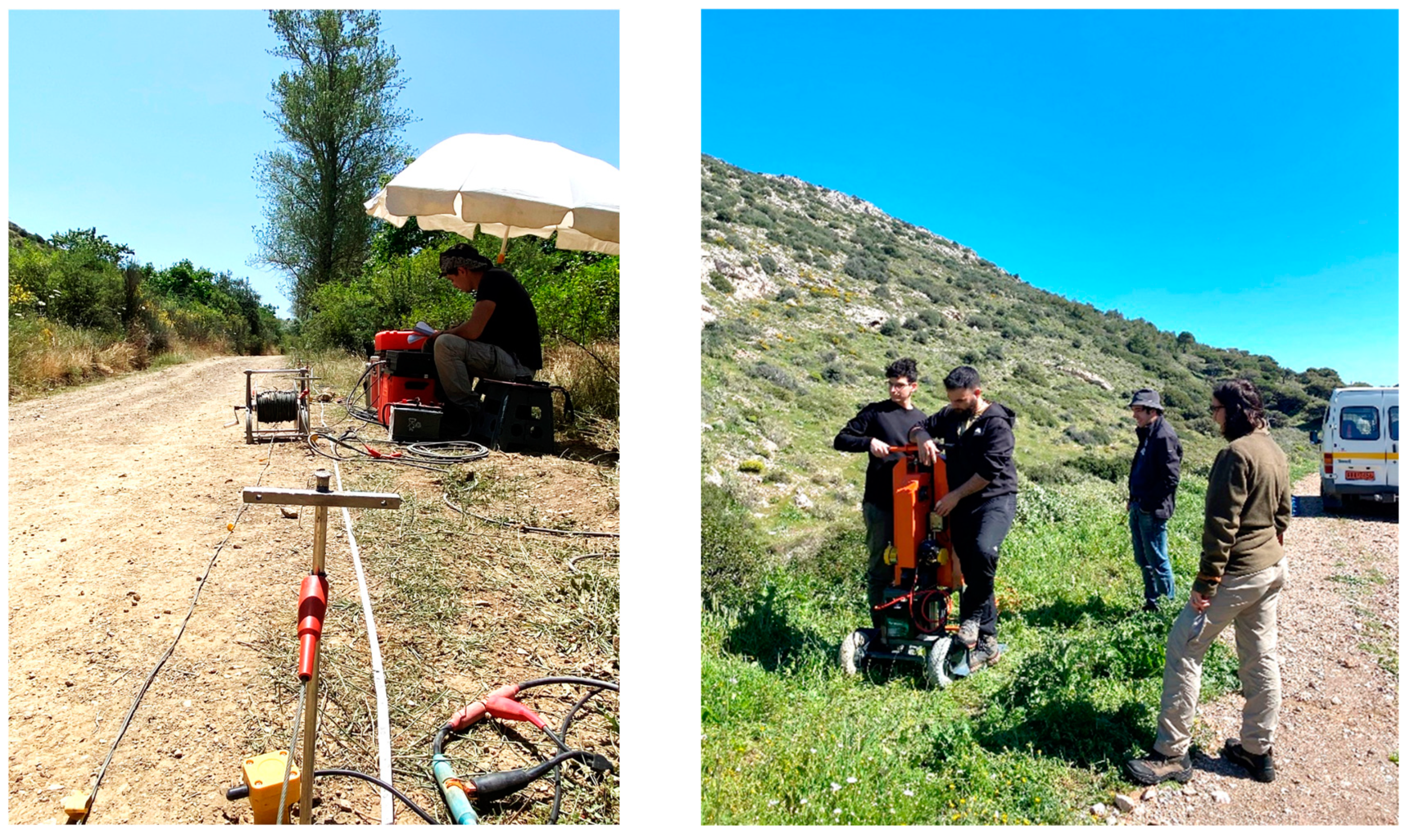
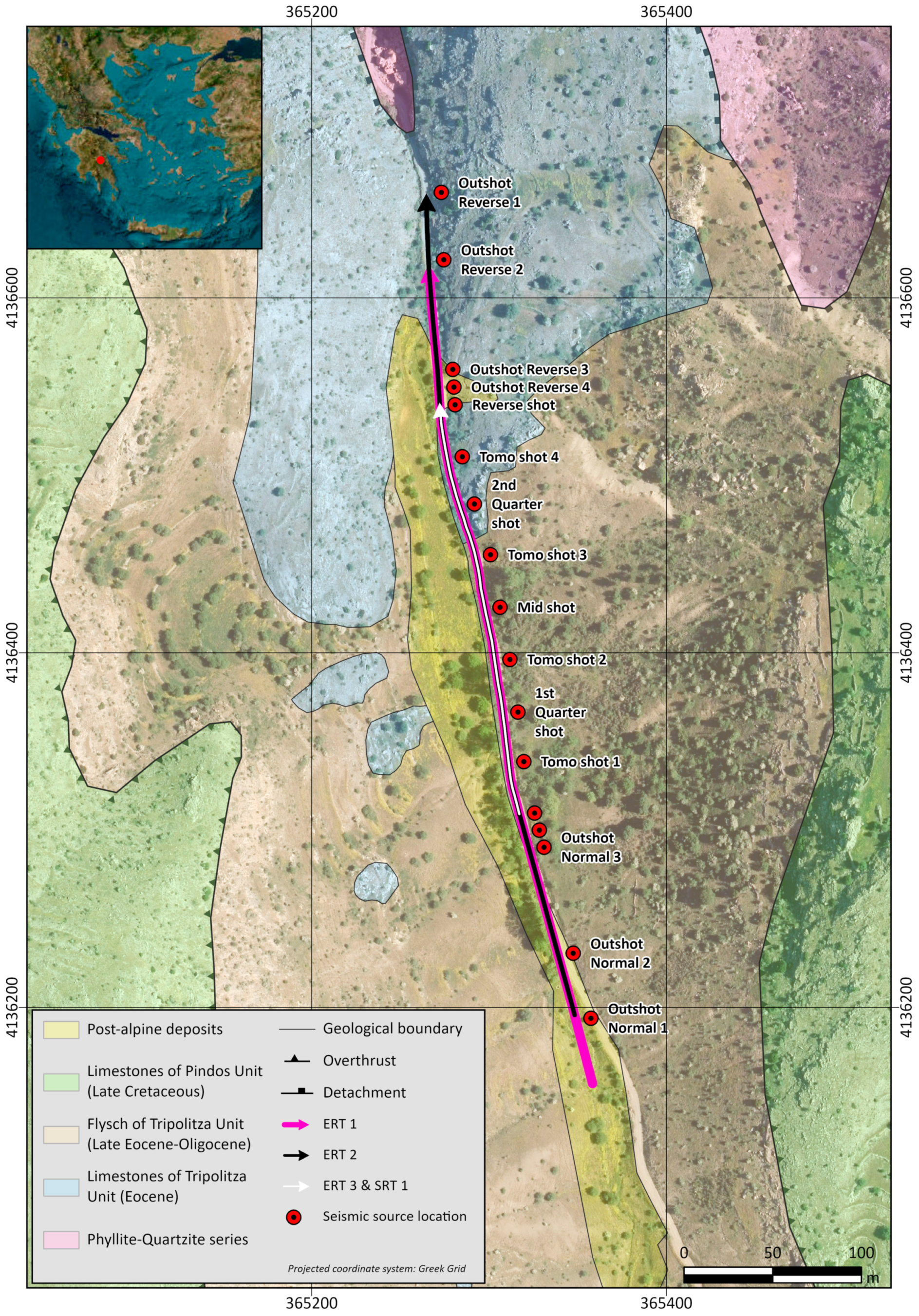
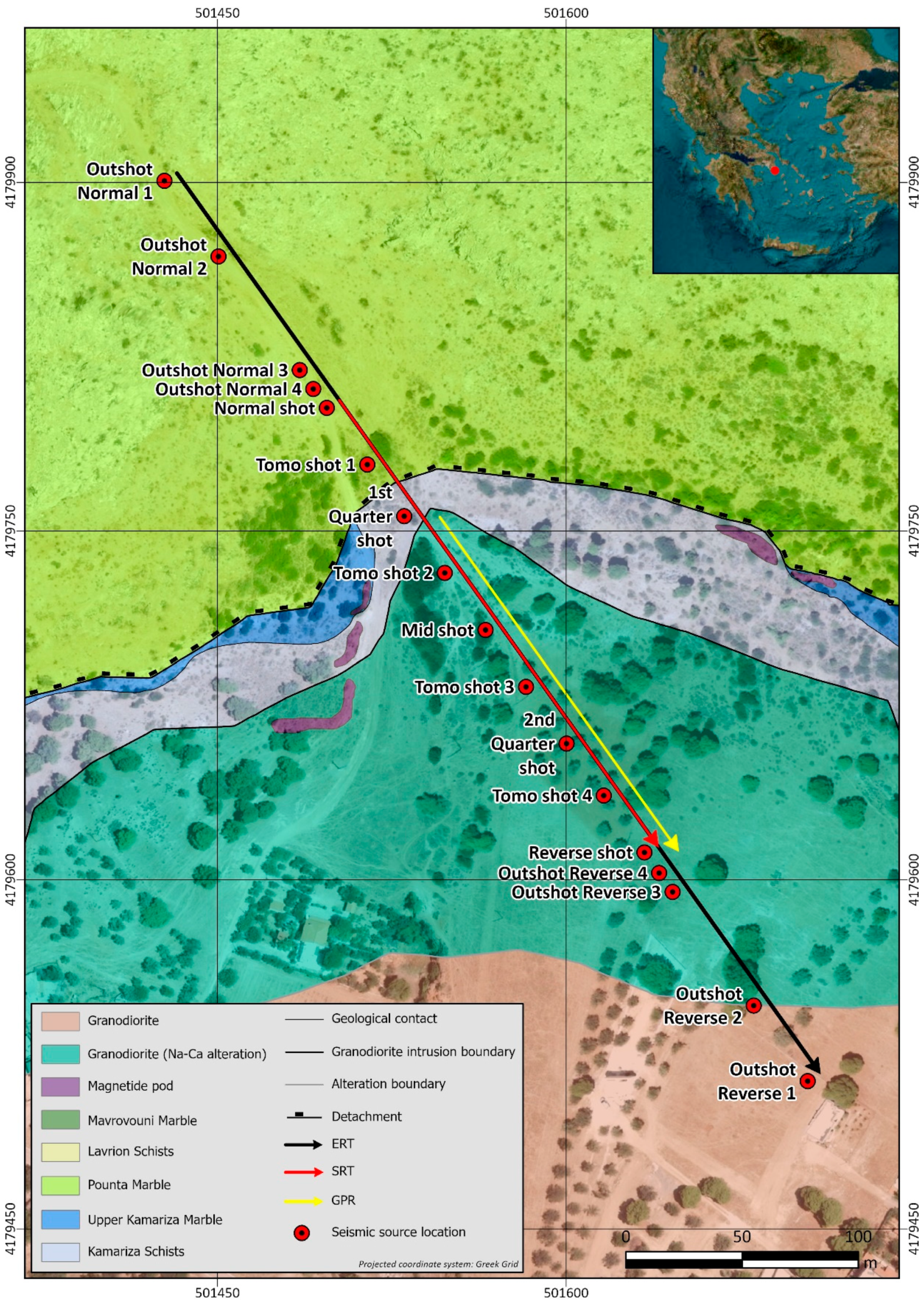
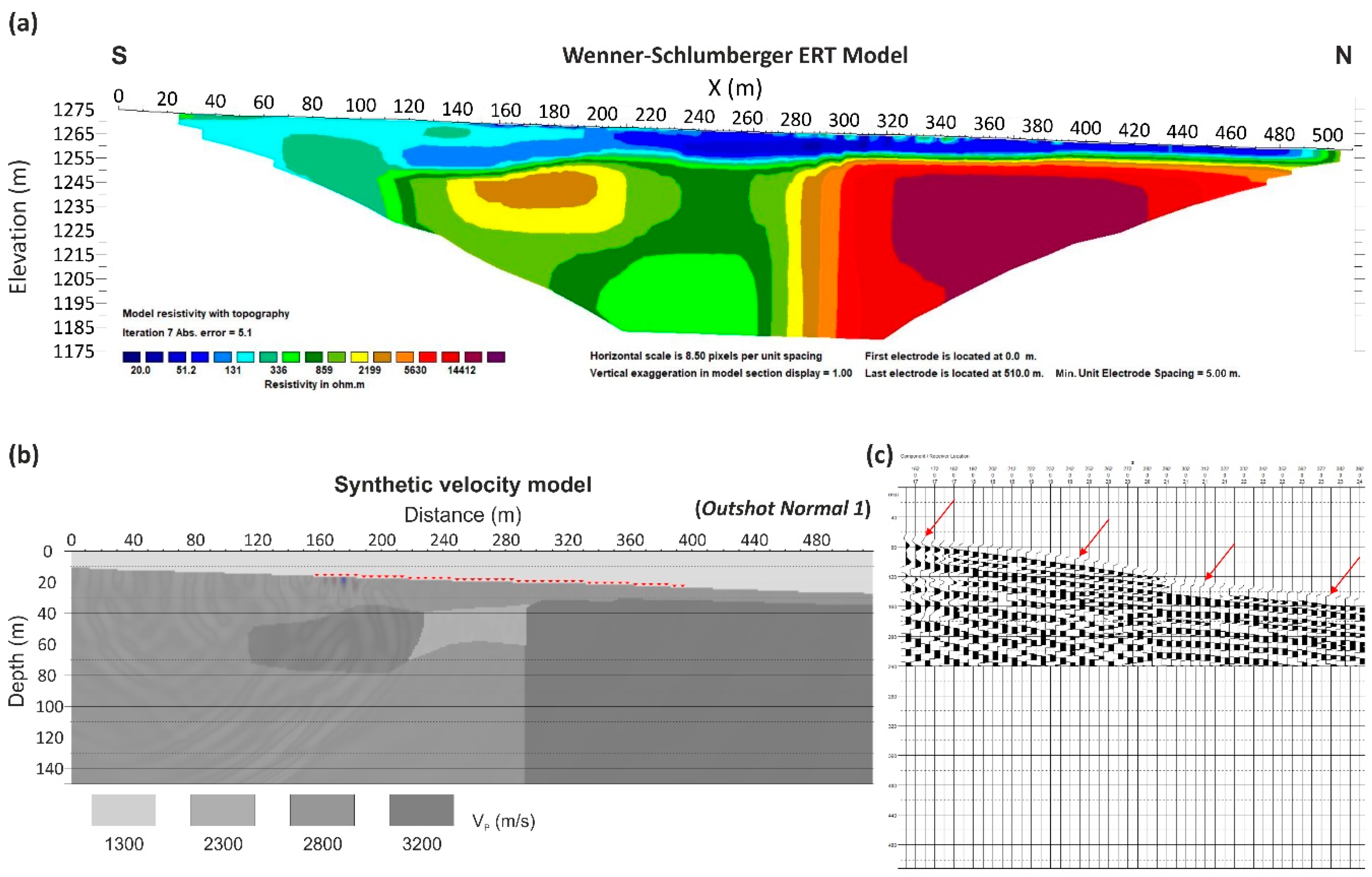
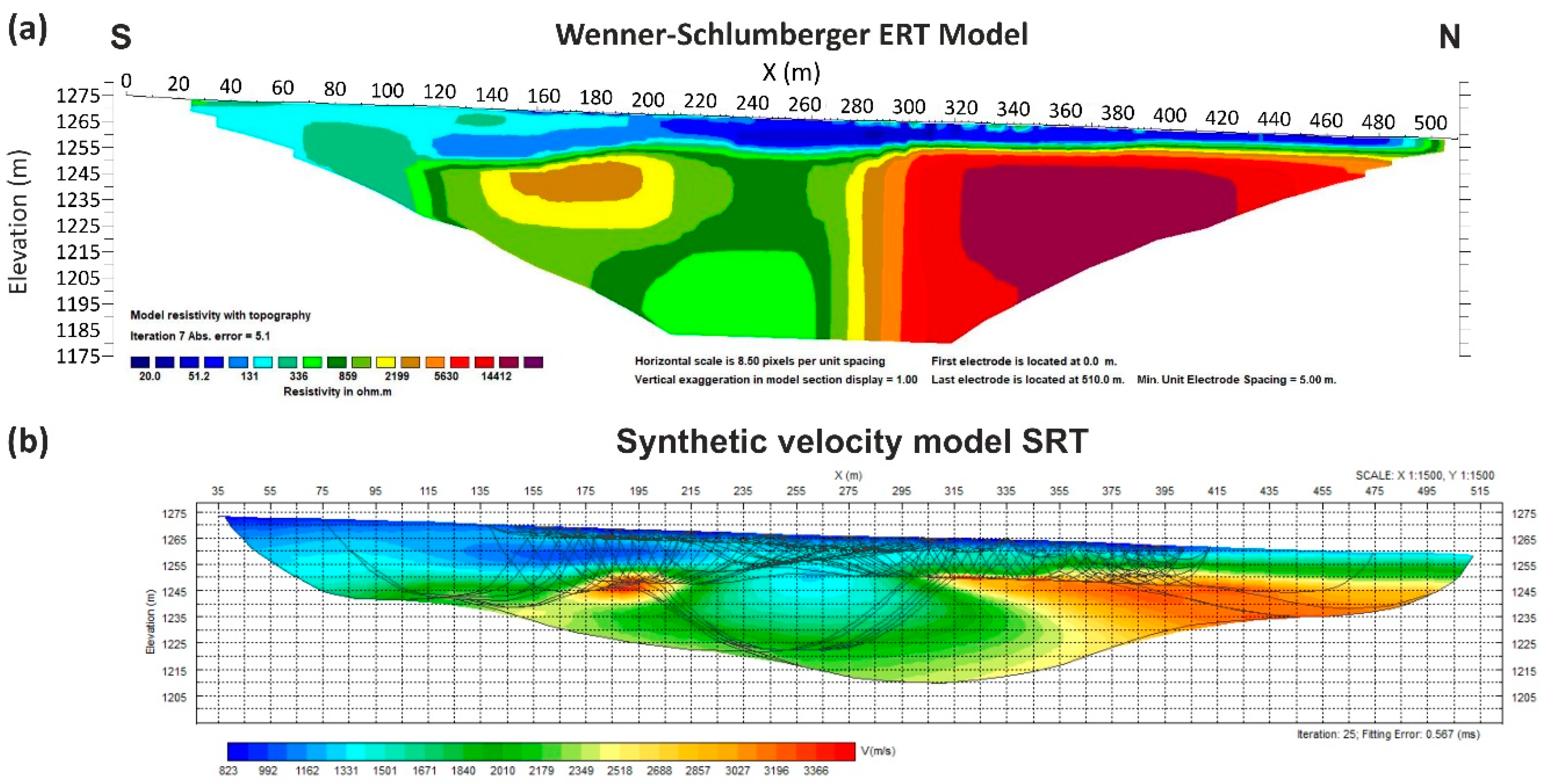
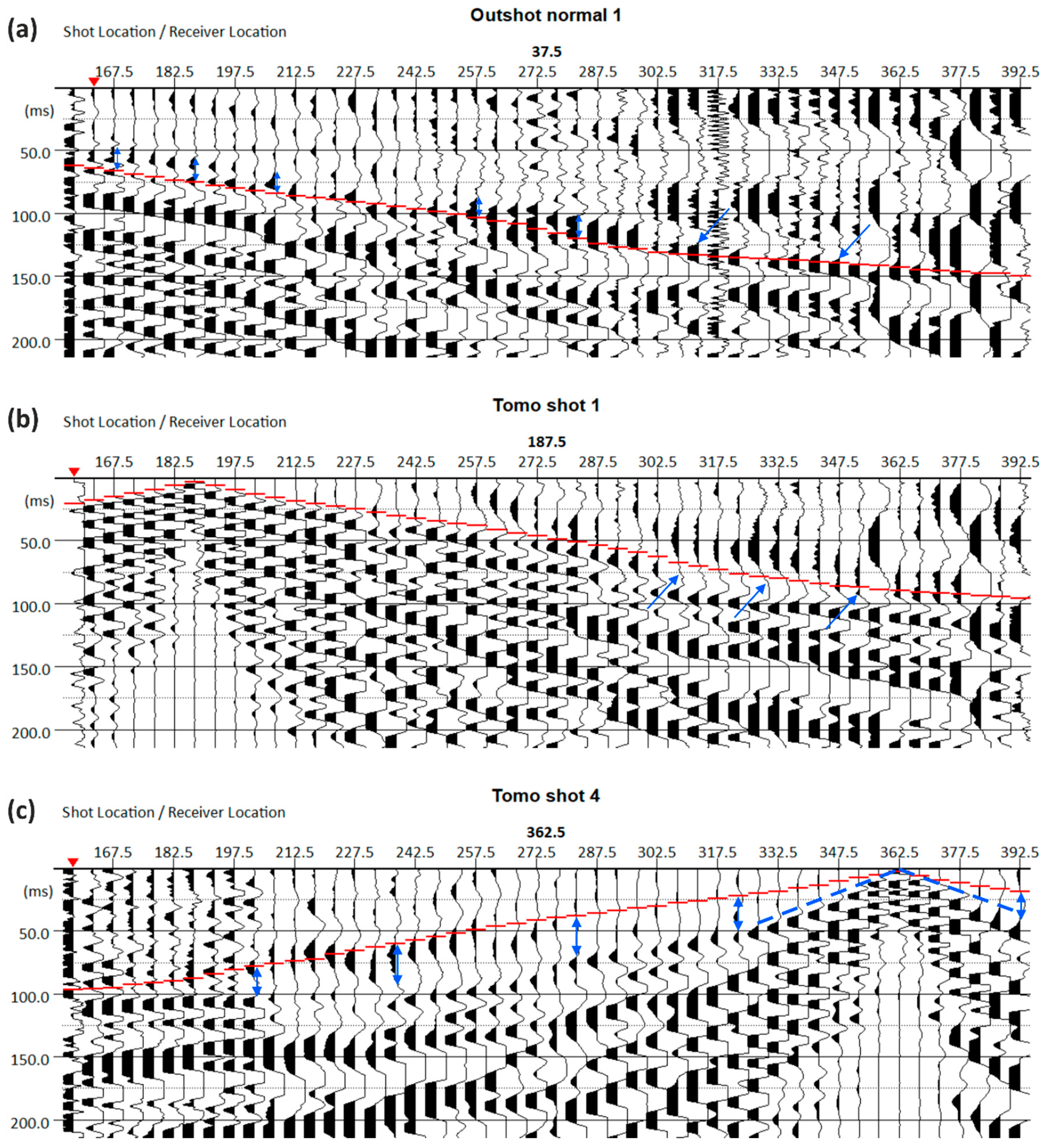
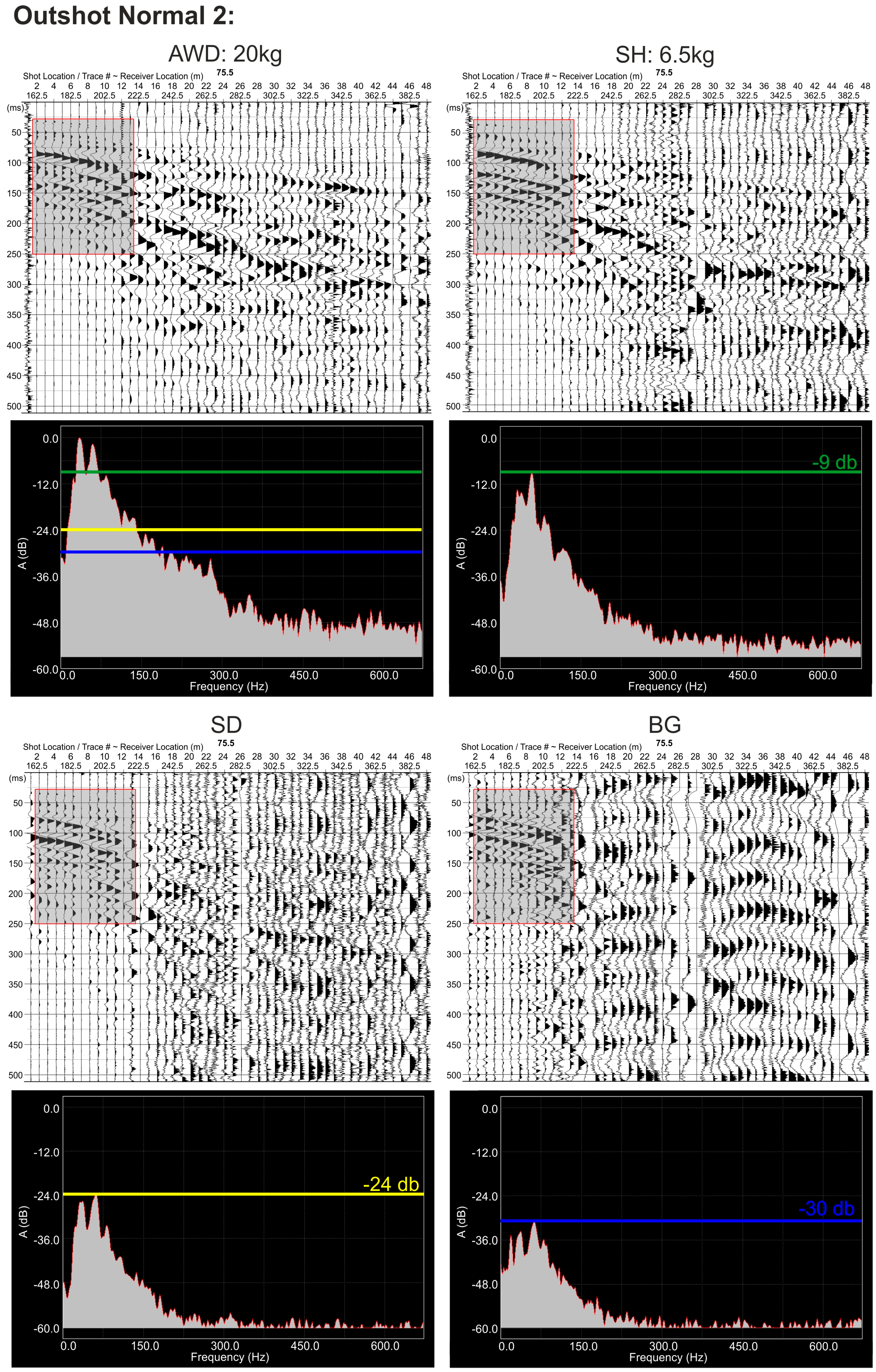
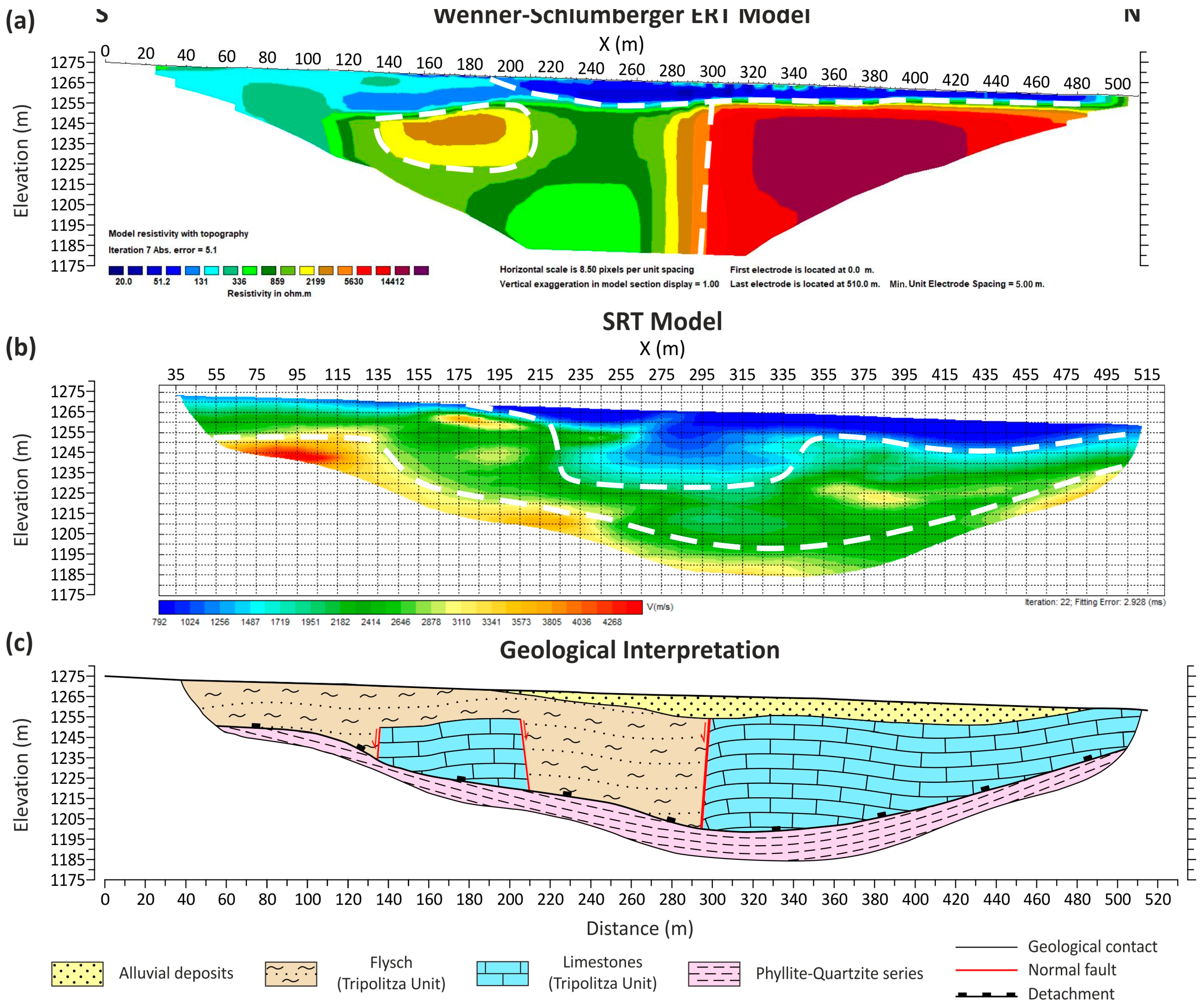
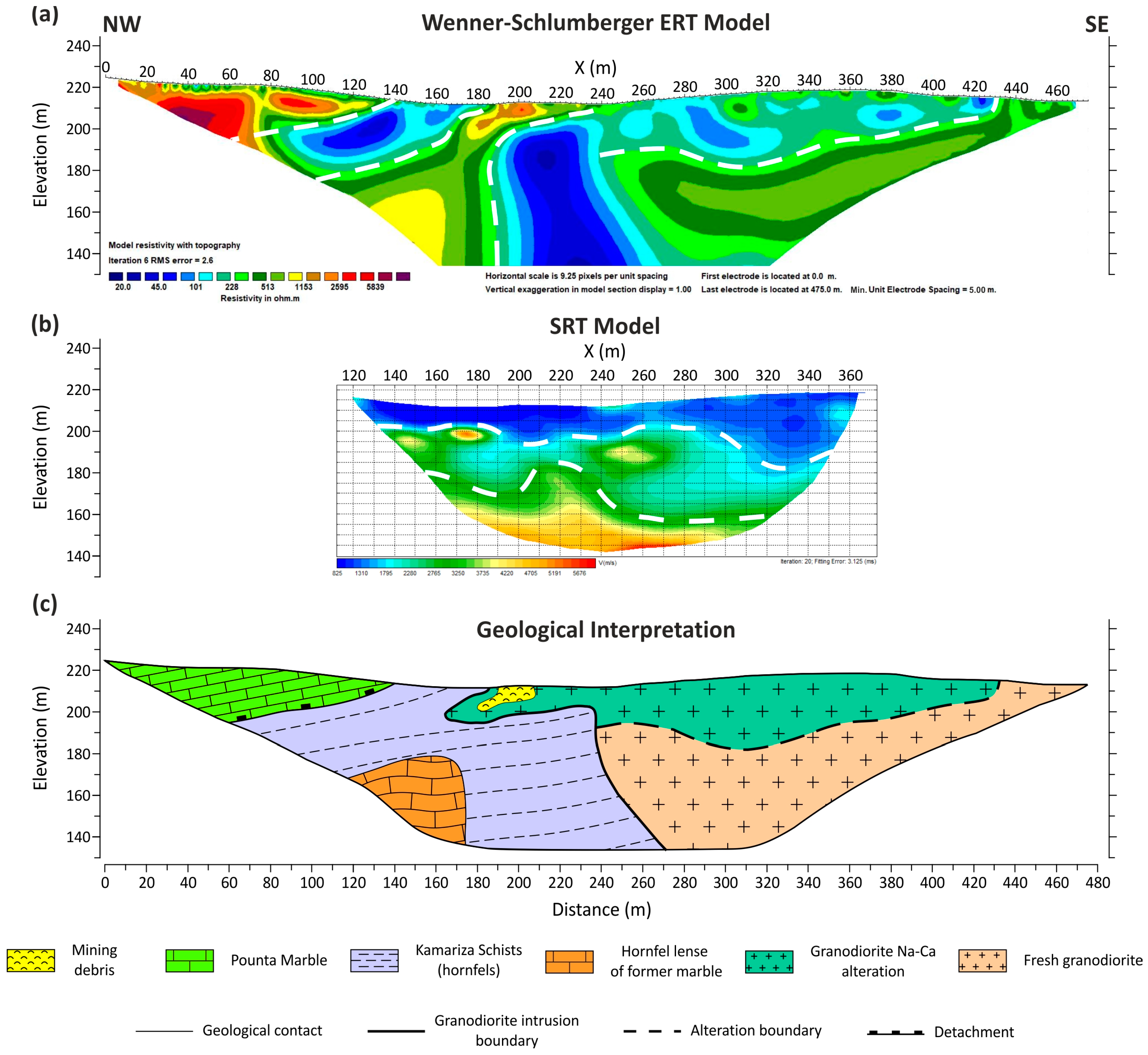

Disclaimer/Publisher’s Note: The statements, opinions and data contained in all publications are solely those of the individual author(s) and contributor(s) and not of MDPI and/or the editor(s). MDPI and/or the editor(s) disclaim responsibility for any injury to people or property resulting from any ideas, methods, instructions or products referred to in the content. |
© 2024 by the authors. Licensee MDPI, Basel, Switzerland. This article is an open access article distributed under the terms and conditions of the Creative Commons Attribution (CC BY) license (https://creativecommons.org/licenses/by/4.0/).




